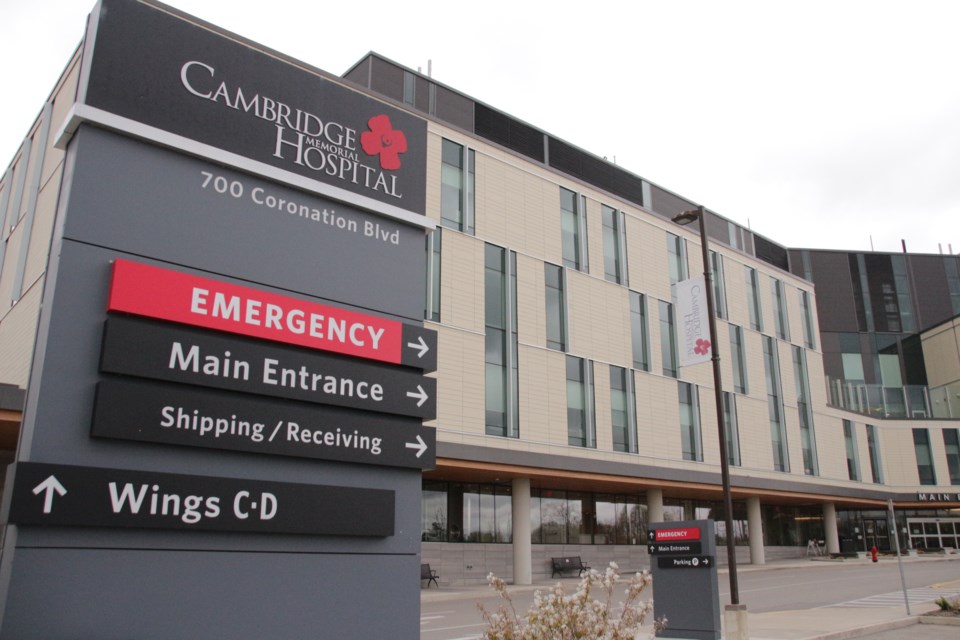Cambridge Memorial Hospital is taking small steps toward a return to open visiting hours while undertaking a “paradigm shift” when it comes to accommodating visits from essential caregivers in the era of COVID-19.
Liane Barefoot, the hospital’s director of patient experience, outlined the move the hospital is making to remove “restrictive wording” from its end-of-life visiting policy during Wednesday’s meeting with the CMH board.
The hospital’s long-standing policy allowed up to four visitors within a 24-hour period and two at a dying patient's bedside.
But since the start of the pandemic, visiting has been restricted at CMH to keep patients and staff safe, and prevent outbreaks as neighbouring hospitals dealt with the majority of COVID-19 patients, Barefoot said.
The policy led to recent calls for CMH to take a more compassionate approach, especially when it comes to patients who are nearing death.
So, the hospital decided to move away from “imminent end of life” language to more liberal determination when giving front-line staff direction around family or caregiver visits.
The new policy also expands the determination to a two week period “where those deeper conversations and cognition can be had.”
It means “if families are asking us to do something that the answer is not no, but perhaps ‘for safety reasons we can’t do that, but perhaps we can do something else,’” explained Barefoot, particularly for patients who are in a ward room or semi-private room.
She said the change in policy has brought front-line nursing staff “a lot of relief because this has been a huge, huge ethical challenge for many of the staff.”
“They’re really embracing this and being creative with how we can do this,” she added.
Barefoot said two recent e-mails from family members whose loved ones were hospitalized and died during the pandemic highlighted the need for change.
She presented two quotes from the emails that stuck with staff.
“It feels cruel and unnecessary and is inconsistent with science and patient-centred care. I urge you to update you (end of life visiting) policies immediately for my father and other patients like him.”
The second email read, “Because she did not meet the definition of ‘imminent end of life’ she did spend the majority of her final days alone, confused and frightened. Unfathomable!!!”
“I’m sure I can speak for everyone around the table,” Barefoot said. “When we received these, this really hurt us, particularly the first one that came at the end of May.”
The emails were “a call to action for us," she added.
The timing coincided with the release of the province’s reopening plan as well as a science table report that concluded hospital visitors have not been known to spread the virus, particularly essential care partners.
“This is someone the patient has identified as being Important to their spiritual, physical and mental well-being in the healing journey that they’re on while they’re sharing that time with us at the hospital,” Barefoot said.
Visits from close family members and friends who are designated caregivers, have been known to provide much more benefit than potential harm during someone’s final days, Barefoot said.
But the new policy will also be reflected in visits and caregiver support in other departments.
Barefoot said the COVID-19 operations table in Toronto has provided direction to hospitals across the GTA to standardize how they were going to allow essential care partners back into hospitals.
CMH determined it was already doing well in respect to visitor policy in its emergency department and its women’s and children’s program, where it matched or exceeded visitor recommendations for Step 1 and 2 of the province’s reopening framework.
The documents, said Barefoot, allowed staff to “hold the mirror up to ourselves and say, ‘what is it that we’re doing well compared to these recommendations and where do we really have the biggest gaps’
The “biggest glaring gap” was around end-of-life situations, she said.
Barefoot added the policy change is a “stepping stone” toward the hospital's “end game” of getting back to open visiting hours as the province and region continues to open up.
